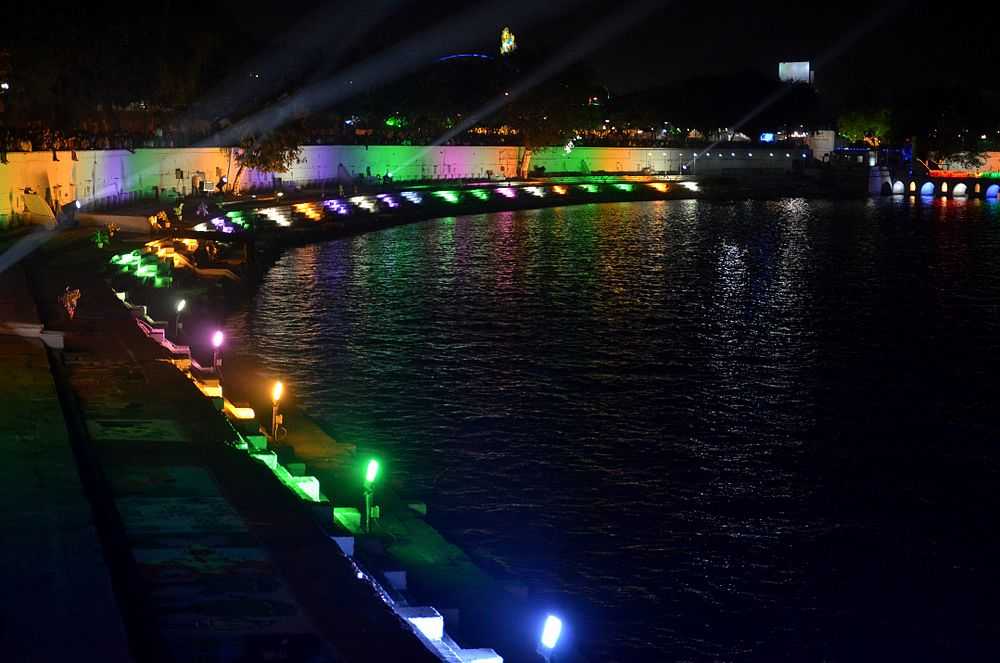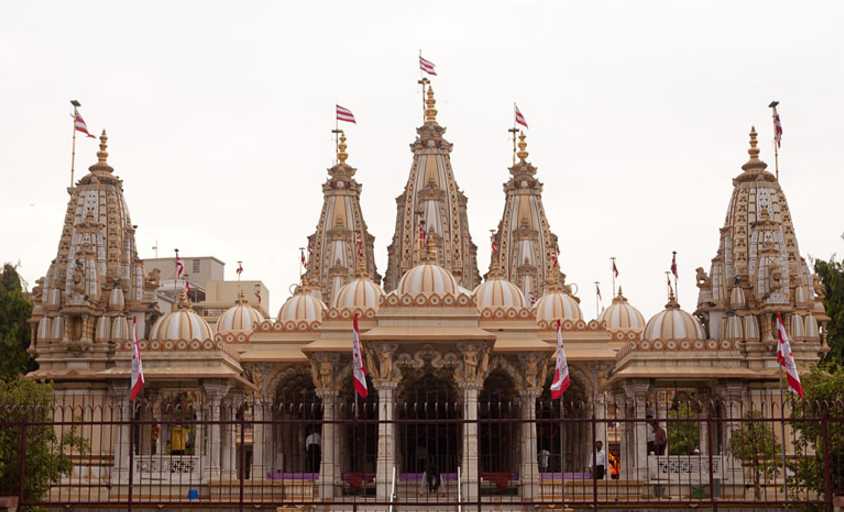1- Swaminarayan Temple, Ahmedabad
Swaminarayan Temple, Ahmedabad Overview
Located in the Kalupur area of Ahmedabad, Shri Swaminarayan Temple (also known as Akshardham Temple) is a shrine dedicated to Narayan Dev. This splendid temple was built in the year 1822 on the instructions of Swaminarayan, who was the founder of the Swaminarayan sect of Hinduism. Embellished with vivid colours and intricate carvings, Swaminarayan temple is a marvellous example of the architecture of the nineteenth century. Inside the sanctum, the deities are decorated with ostentatious ornamentations and beautiful fabrics. The temple attracts a million people on the day after Diwali for darshan.
2- Dada Hari Wav

Dada Hari Wav, Ahmedabad Overview
Built by a woman of Sultan Begara's harem in 1499AD, these step-wells were made as a retreat during hot summers. Waiting to be filled with rain water, no matter what the weather is, it is always cooler within the Step-wells.
This ancient structure depicts the architecture of the bygone era. At ground level, much might not be visible. But as one rises just a little (with the help of stairs) there is suddenly a deep cascade of steps plunging down several stories, intricate carvings reflecting in the sunlight.
3-Sabarmati Ashram
Sabarmati Ashram, Ahmedabad Overview
Once the residence of Mahatma Gandhi and his wife Kasturba, Sabarmati Ashram is undoubtedly the biggest tourist attraction situated in the 5km north of Ahmedabad's centre, Gujarat. Located on the tranquil and serene stretch of Sabarmati River, it is also referred to as the 'Gandhi Ashram', 'Mahatma Gandhi Ashram' and most importantly, 'Satyagraha Ashram' as Gandhi began the famous 'Dandi March' from here. It is believed that Mahatma Gandhi chose this site for it is located between a prison and a cemetery and a Satyagrahi is likely to end up in one of these. In gratitude of the substantial impact Dandi march had on the Indian independence movement, the Indian government has recognised the Ashram as a national monument.
The Mahatma Gandhi Ashram has a number of other establishments within its bounds. The most famous among them is the museum 'Gandhi Smarak Sangrahalaya' which has some of Gandhi's personal letters and photographs on display. The museum was initially located in Hridaya Kunj, Gandhi's own hut in the ashram, but was formally shifted here when the museum was built in 1963. There are other buildings and sites within the Gandhi Ashram known as Nandini, Vinoba Kutir, Upasana Mandir, and Magan Niwas. These buildings are named after people who were close to Gandhi.
4- World Vintage Car Museum

World Vintage Car Museum, Ahmedabad Overview
A connoisseur of vintage cars converted his private collection of vintage cars into a museum. The collection comprises of the best of the world - Rolls Royce, Bentley, Jaguar, Cadillac, Austin and many more.
The most interesting bit here is that you can get to drive the cars by paying a fee of Rs.500 for a fixed distance.
5-Kankaria Lake

Kankaria Lake, Ahmedabad Overview
The second largest lake of Ahmedabad, formerly known as Hauz-e-Qutub, Kankaria Lake was built in the 15th century and was later revamped in 2008. Located in the south-eastern part of the city, it is a complete package of entertainment for your family. A pathway circumscribes the lake which has alluring activities and adventures for people of all age groups.
From balloon safari and zoo to toy trains and amusement park, Kankaria Lake has it all. You can also just rejuvenate in the garden as life in Ahmedabad city unfolds around you. The ecstatic ambience with high-spirited people is a cherry on the cake. It is perfect for evening strolls with multi coloured lights glowing all around its periphery. For adventure buffs, Kankaria Lake lays down a plethora of options for like archery, gymnastics and water rides. The most beguiling festival- Kankaria carnival is celebrated with immense vim and vigour. And you are wrong if the festival seems only a source of amusement to you! It also provides you with a great platform to showcase your talent in different competitions.
Kankaria Lake is a place where entertainment, culture, knowledge and talent perfectly blend with each other. Looking for a place where you can have ultimate fun with your family? Just head out to Kankaria Lake!
6- Hathisingh Jain Temple

Hathisingh Jain Temple, Ahmedabad Overview
Dedicated to the 15th Tirthankara of Jains, Dharmanath, this two-storied white marble structure provides a delightful experience and the tiled courtyard is another unique aspect of the temple.
The courtyard is encircled by daunting row of pergolas with 52 shrines and each shrine shows remarkable designs and fine carvings. Named after Sri Hathee Singh, this temple follows an architectural pattern of the Diwara Jain Temples of Rajasthan.

